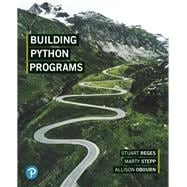NOTE: This loose-leaf, three-hole punched version of the textbook gives students the flexibility to take only what they need to class and add their own notes – all at an affordable price.
For courses in Java programming.
A layered, back-to-basics approach to Python programming
The authors of the long successful title, Building Java Programs, bring their proven and class-tested, back-to-basics strategy to teaching Python programming for the first time in Building Python Programs . Their signature layered approach introduces programming fundamentals first, with new syntax and concepts added over multiple chapters. Object-oriented programming is discussed only after students have developed a basic understanding of Python programming. This newly published textfocuses on problem solving with an emphasis on algorithmic thinking and is appropriate for the two-semester sequence in introductory computer science.










